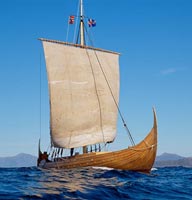 When the sun was out the Vikings could navigate with “sun compass,” a sort of modified sundial. According to legend, when the sky was overcast the Vikings used a “sunstone.” A new study suggests that the sunstone might not have been legend.
When the sun was out the Vikings could navigate with “sun compass,” a sort of modified sundial. According to legend, when the sky was overcast the Vikings used a “sunstone.” A new study suggests that the sunstone might not have been legend.
Did Vikings navigate with ‘sunstone’?
Vikings could have navigated the oceans in inclement weather with the aid of a crystal that pinpointed the sun’s location behind banks of clouds and fog, a new study suggests.
Such a tool, known as a sunstone, is known from legend, but until now experimental evidence that it could actually work as hypothesized was lacking.
Researchers led by Gábor Horváth of Hungary’s Eötvös University decided to see if the legend has real world legs. Their results were published online on Monday in Philosophical Transactions of the Royal Society B.
The theory
The Vikings were Scandinavian seafarers who traveled widely in the North Atlantic, roughly between the year 900 and 1200. Under clear and partly cloudy skies, archaeological evidence indicates that they used sundials to find their way around.
But a sundial is only useful when the sun is shining, raising the question of how the Vikings navigated in cloudy and foggy conditions, which can last for days along their known sailing routes.
In the 1960s, Danish archaeologist Thorkild Ramskou suggested that the Vikings used a sunstone to filter the sunlight so that it all had the same polarization, or direction. By rotating the crystal to and fro, the light would appear brighter or darker, depending on how the crystal was oriented. The brightest point would be toward the direction of the sun.
Two sunstone readings from different points in the sky would allow navigators to pinpoint the sun’s location. They could then hold up a torch in that direction to mimic the sun’s location, allowing its light to cast a shadow on the sundial.
The tests
Critics have questioned whether this technique was actually needed, since experienced navigators could likely estimate the position of the sun even in cloudy weather. They also questioned whether the method would actually work under cloudy and foggy skies.
To answer the critics, the researchers made photographs of cloudy skies with a fisheye lens and asked subjects in the lab to find the sun. The experimental subjects had errors as great as 99 percent, leading the researchers to report that “Viking navigators might have needed some aid to navigate on open seas during cloudy or foggy weather conditions.”
So they tested out the sunstone idea under a range of weather conditions on expeditions to Tunisia, a sail across the Arctic Ocean, and at home in Hungary. For a “sunstone” they used a polarimeter, a device that measures polarization.
Their results showed that the method worked in cloudy and foggy weather, though the method wasn’t as reliable under completely overcast skies. Further research will test whether the actual crystals from Scandinavia and Iceland work as well as the sensitive polarimeter
